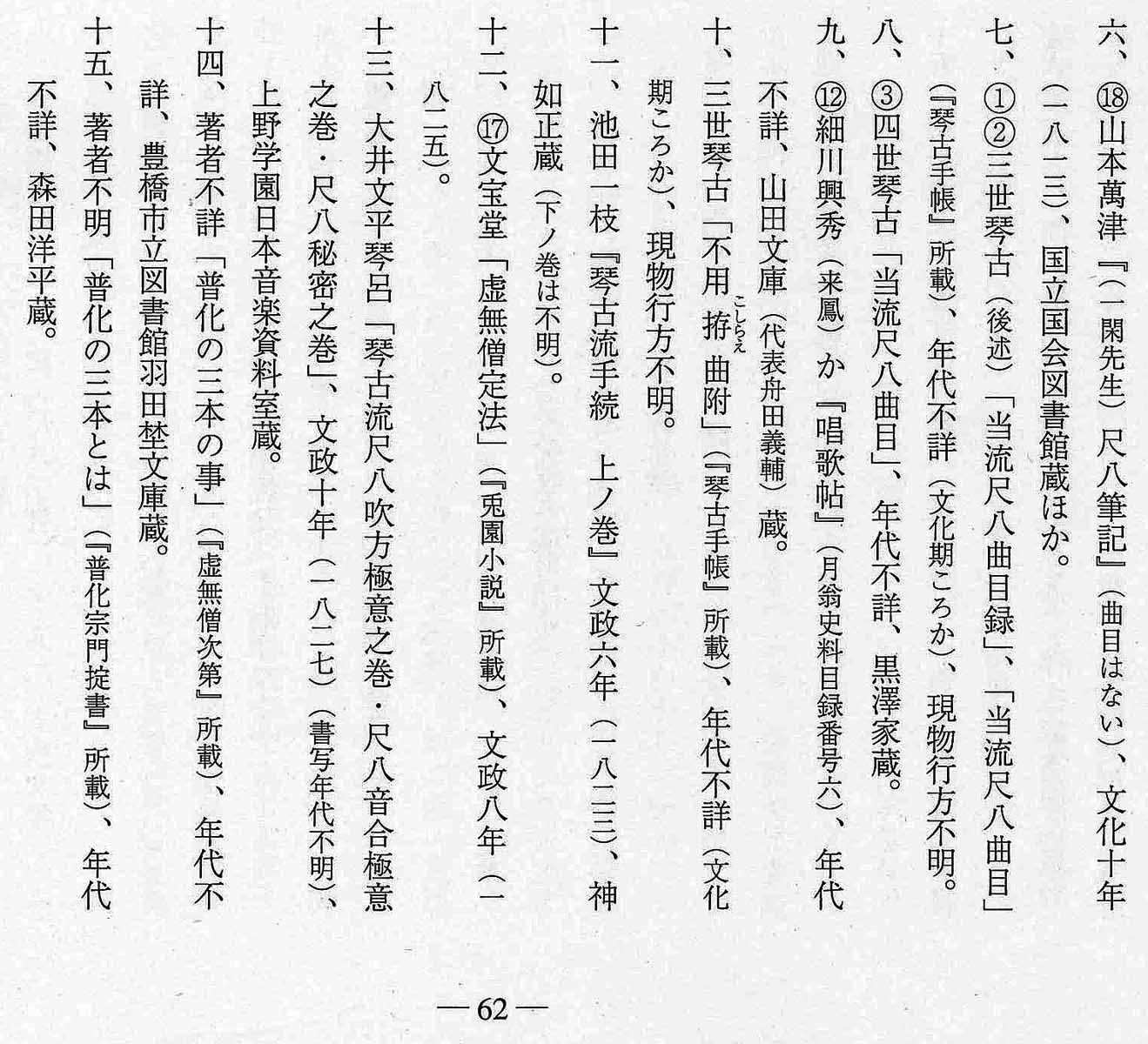|
1732: The Shakuhachi denrai-ki and Early '(Hon)Kyoku' History
This uniquely important document contains a list of 34 shakuhachi music piece titles, the earliest known of its kind.
尺八伝来記 - SHAKUHACHI DENRAI-KI
"ACCOUNT of the TRANSMISSION of the SHAKUHACHI".
Dated Kyōhō 17 - 1732 in the document itself.
It is very significant to notice that the term 'Fuke-shū:',
普化宗, "Fuke Sect", does not appear in the document's text, at all!
Name of alleged author, given in the middle of the text, between the introduction and the list of music titles:
Fusō Sanjin Kakushin, 扶桑散人覚心, The Japanese "Useless" Kakushin.
That piece of information ought of course be taken with more than just a grain of salt.
According to the comprehensive shakuhachi website
shakuhachi-genkai.com, edited and webmastered by Katurayama Genkai, the Shakuhachi denrai-ki was related with and possibly produced by the "twin temples" Reihō-ji and Ichigetsu-ji in Edo.
The complete text of the Shakuhachi denraiki is reproduced in Komusō zakki,
虚無僧雑記,
an anthology of Edo Period shakuhachi-related texts and pictures that was originally compiled/authored by Okumura Noriyoshi,
奥村得義, who lived from 1793 to 1862.
In 1843-44 (Tenpō 14-15), the scholar and writer Kodera Gyokuchō,
小寺玉晁, 1800-1878 - a retainer of the Owari clan, Nagoya - borrowed and copied the material, then annotated and prepared the work for eventual publication.
However, according to the shakuhachi historian Yatō Osamu,
矢頭治, Komusō zakki may first have been presented in final print as late as in 1871, or later.
Link: Komusō zakki
Only recently, a reprint of the book was re-published by the bookstore
Mytown in Nagoya, Japan
Okumura Yoshinori (compiler) & Kodera Gyokuchō (editor):
Komusō zakki, 虚無僧雑記,
"Komusō Note Book",
an anthology of Edo Period shakuhachi-related texts and pictures that was originally compiled/authored by Okumura Noriyoshi,
奥村得義, who lived from 1793 to 1862.
The shakuhachi music piece title list is reprinted in Nakatsuka 1979, pp. 548-549.

List of 34 early shakuhachi '(Hon)Kyoku' in the 'Shakuhachi denraiki'.
Source: Nakatsuka 1979, pp. 548-549.
The complete Shakuhachi denrai-ki as reproduced in a reprint of the Komusō zakki, published by the book store
Mytown in Nagoya, Japan







List of 34 early shakuhachi '(Hon)Kyoku' in the 'Shakuhachi denraiki'.
Source: 'Komusō zakki',
虚無僧雑記,
possibly quite late Edo Period.
PRELIMINARILY PROPOSED TRANSLATIONS of the MUSIC PIECE TITLES as of March, 2018
'Mukaiji', 'Kokū' & 'Kyorei' are, of course well known 'honkyoku' titles - where as 'Sugo[mori]' could be 'Tsuru no sugomori', although we shall never know for sure.
All the remaining titles are really obscure - difficult to translate and make much sense of today. We have no idea of ascertaining whether the music represented with these titles ever existed as the titles has not been mentioned nor corroborated in any other surviving source document.
Do note that 'kana' characters appearing in brackets are reading suggestions offered by Katurayama Genkai on the above mentioned shakuhachi-genkai.com webpage.
1: 霧海箎
Mukaiji - Flute of the Misty Sea
2: 虚空
Kokū - Non-dual Space (lit.: Empty Sky)
3: 虚霊
Kyorei - Non-dual Spirit (lit.: Empty Spirit)
4: 巣籠
Sugo[mori] - Nesting; Resting in the Nest
5: 律虚霊
Ritsu Kyorei - Ritsu Scale Kyorei
6: 鈴虚空
Rin/Rei Kokū - Bell of Non-dual Space
'Kyorei' pieces, "Non-dual Spirit pieces":
7: 雲響虚霊
Unkyō Kyorei - Sound of the Cloud(s) Kyorei
8: 窪訓虚霊
A-kin/A-kun Kyorei - Reading/Explaining The Hollow (Non-duality),
or the sound/letter 'A' Kyorei
9: 聲廣(声広)
虚霊
Shōkō/Seikō Kyorei - Spreading out of the Voice Kyorei
10: 葭岡虚霊
Kakō Kyorei - Reed Hill Kyorei, or Yoshioka Kyorei (place name?)
11: 遏雲虚霊(アツウン)
Atsu-un Kyorei - Stop the Cloud Kyorei
12: 虹啜虚霊(コウセツ、コウテツ)
Kō-setsu Kyorei - Sipping the Rainbow Kyorei
13: 翰敬虚霊(カンケイ、ガンキョウ)
Kankei/Kankyō Kyorei - Writing Brush Reverence Kyorei
14: 落梅虚霊(ラクバイ)
Raku-bai Kyorei - Fallen Plum Blossom Kyorei
15: 緩端虚霊(カンタン)
Kantan Kyorei - "Moderate Origin" Kyorei?
16: 遶梁虚霊(ジョウリョウ)
Jōryō Kyorei - "Surrounding the Bridge Beam" Kyorei?
'Renbo' pieces, "Love and Affection" pieces:
17: 意律戀慕(恋慕)
I-ritsu Renbo - Thought+Rule Renbo
18: 武田戀慕(恋慕)
Takeda Renbo - Takeda Renbo
19: 風情戀慕(恋慕)
Fūjō Renbo - Elegance Renbo
20: 鳴渡戀慕(恋慕)
Mei-to Renbo - Chirp Delivery Renbo
21: 善也戀慕(恋慕)
Zen-ya Renbo - Zen-ya Renbo
22: 和霧戀慕(恋慕)
Wa-mu Renbo - Peaceful Mist Renbo
23: 吟静戀慕(恋慕)
Ginsei Renbo - Recital Stillness Renbo
24: 縅朧戀慕(恋慕)(イロウ)
I-rō Renbo - "Frightening Haziness"? Renbo
25: 調音戀慕(恋慕)
Chō-on Renbo - Pitch+Sound Renbo
26: 諍達戀慕(恋慕)(静達、ショウタツ?)
Shōtatsu Renbo - "Dispute+Friend" Renbo or "Stillness+Friend" Renbo
27: 了祖戀慕(恋慕)
Ryō-so Renbo - Understanding+Forefather Renbo
28: 志道戀慕(恋慕)
Shidō Renbo - The Way of Intention Renbo
29: 情緩戀慕(恋慕)(ジョウカン)
Jōkan Renbo - Moderation of Compassion Renbo
30: 得秀戀慕(恋慕)
U-jū Renbo - Acquire Superlativeness Renbo
31: 遊戯戀慕(恋慕)
Yūgi Renbo - Game/Sports Renbo
32: 總譜(総譜)戀慕(恋慕)(ソウフ、スフ)
Sōfu/Sofu Renbo - "Collected Music"? Renbo
33: 薄暮盤濤(盤涛)
Haku-bo Bantō - Twilight Dish+Wave
34: 霊法流
Reihō/Reipō Ryū/Nagare - Spirit Law Manner,
i.e. "In the Manner of the Spirit Dharma"?
HISTORICAL HONKYOKU and SHAKUHACHI KYOKU LISTS
researched by the honourable late Prof. Tsukitani Tsuneko, 月渓恒子 (d. 2010).


Tsukitani Tsuneko's presentation of surviving shakuhachi
solo music title sources (2000, page 62].
As it can be seen, the Shakuhachi denraiki is the very first and oldest on the list,
number 1 at the top right.
Source:
Tsukitani Tsuneko: 'Shakuhachi koten honkyoku no kenkyū.'
"A Study of Classical Shakuhachi Honkyoku."
Shuppan Geijutsu-sha, Tokyo, 2000.
|
|










